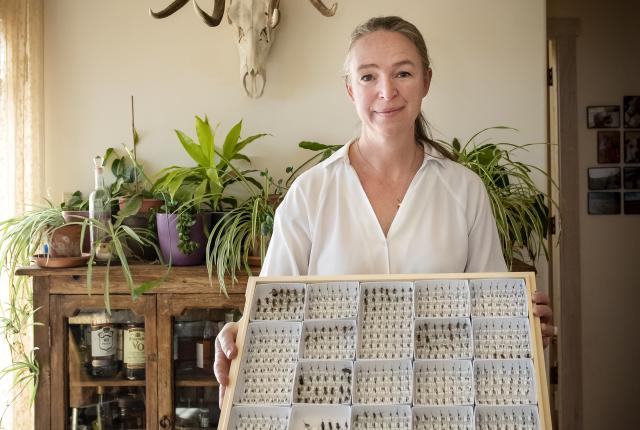Olivia Carril has a honey of a gig. The Santa Fe Girls’ School science teacher and coauthor of The Bees in Your Backyard: A Guide to North America’s Bees (Princeton University Press) travels the state hunting for beautiful flowering plants and watching for bees. Her current research identifies specific bees and the flowers they pollinate in the Río Grande del Norte and Bandelier national monuments, while examining the impacts of grazing, fire, and drought on these important insects. Carril is also studying the relationships among bees and rare plants in Carlsbad, Roswell, and Carrizozo and their habitat requirements in Farmington, Bloomfield, and elsewhere.
BEES ARE MOST DIVERSE in arid regions. And so, while North America is home to about 4,000 species of bees, one-fourth of those live in New Mexico. There are so many discoveries to be made in terms of identifying new species and understanding our native bees. There are huge areas of the state that no one has studied since about 1905. I’m never going to run out of work.
I’ve been giving talks for close to a decade now. In the early days, someone would always ask, “So you’re telling me they’re not all honeybees?” It was hard for people to wrap their brains around this idea that the honeybee is the weirdo and not like the rest of them. In fact, most bees in our state are solitary. Only honeybees and bumblebees live in colonies. There’s been this huge, inspiring effort to embrace these creatures that used to be thought of as scary.
There are a lot of stories in the news that have contributed to the idea that bees are fragile and on the brink of extinction. There is definitely evidence that bees are in decline and need our help. But it’s not quite as bad as you think. Bees are diverse, very resilient, and opportunistic. A tiny tweak is all it takes to help bees. They don’t need much encouragement to join you in your yard. Leave the dead plant material at the end of the year for nesting bees. Nurture plants that attract a lot of bees: sunflowers, globe mallow, anything in the mint family. Bees will thank you.—As told to Christina Selby.


